Showing posts from category *Main.
-
VIDEO: Leona D’Agnes on Population, Health, and Environment
›April 15, 2009 // By Wilson Center StaffIntegrated population-health-environment (PHE) programs “are very cost-effective ways” to develop “community capacity—to strengthen their know-how, and bring…in some additional appropriate technologies” to promote livelihoods, says Leona D’Agnes in this short expert analysis from the Environmental Change and Security Program.
“It doesn’t require a lot of money, but it does require capacity building and being able to motivate communities and help them to understand that it is not just the government that’s responsible for their development. Their own food security and environmental security rests with their abilities to manage their assets, their natural resources, to plan their families, and make sure their children finish school.”
In this expert analysis, D’Agnes, currently a consultant to CDM International on PHE and forestry in Nepal, discusses the linkages between population, health, and environment involved in her work as a technical adviser for PATH Foundation Philippines and its IPOPCORM project.
To learn more about population, health, and environment issues, please visit our PHE page. -
Hardship in Haiti: Family Planning and Poverty
›April 14, 2009 // By Rachel WeisshaarThe New York Times’ Nicholas Kristof aptly describes the connections between poverty and lack of access to family planning in a recent op-ed, using a Haitian woman named Nahomie as an example. He rightly argues that we won’t be able to end poverty until women are able to choose how many children to have. He also notes that relative funding levels for family planning have decreased in recent decades, and that development professionals’ attention has shifted to other issues. Yet 201 million women around the world still have an unmet need for family planning.
One of the few off notes in Kristof’s article, I think, is his portrayal of family planning as a difficult, challenging intervention. Of course, it is more complicated than simply giving birth control pills to women and condoms to men. But community health workers with little formal education have been successfully trained to deliver family-planning services to remote communities in developing countries.
While I recognize he has space limitations, Kristof neglected to mention that in Haiti, poverty and lack of access to family planning are linked to severe environmental degradation and natural disasters. A 2006 U.S. Agency for International Development (USAID) report found that “the root causes of environmental disaster in Haiti are acute poverty, rapid population growth, and unplanned urbanization.” To meet their daily needs, the rapidly growing population resorts to unsustainable agricultural and energy practices that deforest and erode the countryside—or move to increasingly crowded cities.
At a Wilson Center presentation in August 2006, USAID’s Rochelle Rainey reported that 40 percent of Haitian women wished to use contraception but did not have access to it. Modern contraceptive methods are used by only 23 percent of the population, contributing to a total fertility rate of 4.9 children per woman. As Ronald Toussaint, a Haitian biodiversity specialist, said: “If we don’t address population issues, it is like the Creole phrase, ‘wash your hands and then rub them in the dirt.’”
Photo: Children in Haiti. Courtesy of Flickr user Billtacular. -
In Dealing with Climate Change, A Role for Global Governance
›April 14, 2009 // By Will Rogers “The idea of being a citizen of the world is still controversial,” said Strobe Talbott at a March 12, 2009, event examining the “great experiment” of global governance. Nevertheless, Talbott, president of The Brookings Institution, argued that global governance will be key to solving three of the greatest challenges the world faces: nuclear proliferation, climate change, and the financial crisis. This event was co-sponsored by the Wilson Center’s Environmental Change and Security Program and the Environmental Film Festival in the Nation’s Capital.
“The idea of being a citizen of the world is still controversial,” said Strobe Talbott at a March 12, 2009, event examining the “great experiment” of global governance. Nevertheless, Talbott, president of The Brookings Institution, argued that global governance will be key to solving three of the greatest challenges the world faces: nuclear proliferation, climate change, and the financial crisis. This event was co-sponsored by the Wilson Center’s Environmental Change and Security Program and the Environmental Film Festival in the Nation’s Capital.
From Imperialism to Internationalism: The “Great Experiment” of Global Governance
“Bad news has often been the mother of good news” in the long history of global governance, Talbott said. Imperialism “brought fractious tribes and cultures together under a single authority—an attempt at global governance that ultimately failed.”
In the wake of World War I’s destruction came the League of Nations, a stab at global governance that lacked American support and “failed abysmally at preventing the Second World War,” Talbott noted. World War II spawned the United Nations, which was more successful due to the United States’ participation and influence.
From the ashes of the Cold War rose a more interconnected Europe, which Talbott affectionately referred to as the “Euro-mess”—a “system in which multiple countries make common cause in the face of common challenges,” he said. “Part of what we must hope for in the years ahead is the emergence of a more robust ‘globo-mess’—the creation and strengthening of regional and global organizations.”
Global Governance for Global Challenges
According to Talbott, the nuclear arms control treaties exemplify effective global governance in the pursuit of the ultimate common goal: the survival of the human race. “We need to build on past experiences and existing institutions to address challenges like climate change and financial regulation,” he said.
Talbott suggested that we use the existing nuclear nonproliferation regime to build an effective climate control system that ensures that “civilian nuclear power—which we are going to be seeing a lot more of—will be safe and confined to peaceful purposes.”
Similarly, a global financial regime could help bolster the effectiveness of a climate regime by stabilizing the world’s credit markets, enabling them to help “finance commercially viable technologies to end our dependence on fossil fuel,” Talbott said. “If we’re going to have efficient, equitable markets in which to trade in carbon allotments,” we will need a robust global economic regime, as well, he said.
With global governance, “progress has almost always been reactive. But in dealing with climate change, progress needs to be proactive,” as when the world has come together to prevent nuclear war, Talbott said. “If we fail to recognize our own obligations as citizens of the world,” he warned, “we risk, if not our own lives, then the lives of our children and their children.”Photo: Strobe Talbott. Courtesy of Dave Hawxhurst and the Woodrow Wilson Center.
-
Water’s Role in International Development
› A mark of a good event is that it generates further debate, questions, and ideas. “Water and International Development: A Dialogue,” a recent discussion at The Johns Hopkins University School for Advanced International Studies, was such an event. Geoff Dabelko, director of the Environment Change and Security Program at the Wilson Center, and Aaron Salzberg, special coordinator for water resources at the U.S. Department of State, went head-to-head to discuss water’s role in international development.
A mark of a good event is that it generates further debate, questions, and ideas. “Water and International Development: A Dialogue,” a recent discussion at The Johns Hopkins University School for Advanced International Studies, was such an event. Geoff Dabelko, director of the Environment Change and Security Program at the Wilson Center, and Aaron Salzberg, special coordinator for water resources at the U.S. Department of State, went head-to-head to discuss water’s role in international development.
The discussion between Dabelko and Salzberg touched upon many issues I ran into while trying to program Water for the Poor Act funding while working as a natural resources adviser for the Economic Growth Office at the U.S. Agency for International Development (USAID) mission in Ghana. Once we received the funding, there was an intra-office debate among:- People who wanted to make drip-irrigation work we were already funding fit the Water for the Poor Act definition;
- People who thought the funds should be spent on a narrow set of water and sanitation interventions, such as borehole/latrine construction and water purification tablets; and
- People who thought the funds should be spent on the larger-scale water and sanitation infrastructure that Ghana so desperately needs.
USAID mission offices have specific strategic priorities and associated operational plans, which dictate the makeup of the staff employed at any given time. In this case, there was no one water specialist who could take on this important task. I had an M.S. in water management, so I was passed the baton. If the Water for the Poor Act is going to have a significant impact, USAID missions must have the technical capacity to assimilate the funds.
Dabelko and Salzburg’s discussion brought up even more questions for me: How can the United States reconcile its bilateral earmark funding for water with the growing trend toward donor coordination—for instance, under the 2005 Paris Declaration, or, in the case of Ghana, the Multi-Donor Budget Support fund, which encourages donors to contribute direct financial support to the Ghanaian government to implement its Growth and Poverty Reduction Strategy? Is there a need to have water specialists assigned to USAID missions, rather than relying on specialists in Washington, D.C.? How can we make municipal financing mechanisms for infrastructure more attractive to Western funders and host-country governments? Although Dabelko and Salzburg might not have had all the answers to these questions, I’m heartened that they and other water experts are tackling the tough issues.
David Bonnardeaux is a freelance consultant on rural development and natural resource management for the World Bank, USAID, and CARE, among others. He is also an amateur photographer (www.davidbonnardeaux.smugmug.com). His next port of call is Vietnam.
Photos: Top: Boy pumping water, Volta Region, Ghana. Bottom: Girl collecting water from lake, Volta Region, Ghana. Courtesy of David Bonnardeaux. -
Reading Radar– A Weekly Roundup
›April 10, 2009 // By Wilson Center StaffUncharted Waters: The U.S. Navy and Navigating Climate Change, a working paper by the Center for a New American Security, examines climate change’s implications for the U.S. Navy.
Defense Secretary Robert Gates recently chose Admiral James Stavridis, the former head of U.S. Southern Command known for his “smart power”/“sustainable security” approach, to lead U.S. European Command.
An Economist article highlights some of the linkages between water and political instability, energy, food, demography, and climate change.
The Governance of Nature and the Nature of Governance: Policy That Works for Biodiversity and Livelihoods, a report by the International Institute for Environment and Development, explores the success of local-level conservation. It features case studies from India, Tanzania, and Peru.
Sheila Herrling of the Center for Global Development argues that the USAID Administrator should become a permanent member of the National Security Council.
The Nation wonders whether nations go to war over water; Nature (subscription required) and Slate say “no.” ECSP has weighed in on this issue in the past.
Lisa Friedman of ClimateWire reports on Bangladesh’s attempts to prepare for the impacts of climate change. -
From Assessment to Intervention: Redefining UNEP’s Role in Conflict Resolution
›April 9, 2009 // By Will Rogers “Can we get beyond the point where environment and conflict always has to be a story of tragedy with no happy ending?” asked Achim Steiner at the March 24, 2009, launch of From Conflict to Peacebuilding: The Role of Natural Resources and the Environment, a new report from the UN Environment Programme (UNEP).
“Can we get beyond the point where environment and conflict always has to be a story of tragedy with no happy ending?” asked Achim Steiner at the March 24, 2009, launch of From Conflict to Peacebuilding: The Role of Natural Resources and the Environment, a new report from the UN Environment Programme (UNEP).
“I think we actually can provide a critical set of building blocks that would allow us to be not just lamenters on the sidelines,” but active problem-solvers, said Steiner, UNEP’s executive director. UNEP would like to put “green advisers, so to speak, with blue helmets” to examine peacebuilding “from an environmental, natural resource restoration point of view” and “minimize the potential for conflicts to escalate again,” said Steiner, who recently met with Alain Le Roy, UN undersecretary-general for peacekeeping operations, to discuss plans for embedding environmental advisers with UN peacekeeping troops.
Steiner was joined by Daniel Reifsnyder, deputy assistant secretary for environment at the U.S. State Department, and Andrew Morton, manager of UNEP’s Disasters and Conflicts Programme, to discuss the report’s findings.
Natural Resources and the Conflict Continuum
According to From Conflict to Peacebuilding:- Forty percent of intrastate conflicts within the past 60 years have been strongly linked to natural resources.
- Such conflicts are twice as likely to relapse within the first five years of peace.
- Less than a quarter of peace agreements for these conflicts address natural-resource issues.
Environmental factors can contribute to conflict and subvert peace in three main ways:
- The inequitable distribution of resource wealth, competition for scarce or valuable resources, and environmental degradation can contribute to the outbreak of conflict.
- Natural resources can used as “a financing vehicle for conflict—sustaining conflict well beyond the point where conflict has its origin, to actually having become part of an at-war economy, a conflict economy,” Steiner said.
- Unresolved environmental issues can subvert peace negotiations, especially when warring parties have a stake in lucrative resources. If we do not understand “how environment and natural resources can undermine very volatile peace agreements,” Steiner warned, we can “find ourselves back where we started off from.”
Lessons Learned and the Way Forward
Natural-resource conflicts have direct impacts—like deforestation and desertification—and indirect impacts—like the disruption of livelihoods—that are devastating to communities, Morton said. They also weaken a government’s capacity to manage its industry and infrastructure, like waste management and water purification, creating new environmental problems—and thus possible future conflict.
But the environment also offers opportunities, Morton emphasized. In Rwanda, for instance, “we have gorilla tourism going on within a few kilometers of what, essentially, was a war zone.”
UNEP recommends that peacekeepers:- Assess the natural-resource and environmental issues underlying conflicts.
- Monitor and address natural-resource use in conflict areas.
- Incorporate resource-sharing agreements into peace deals.
- When cooperation is not possible, use punitive measures to end resource exploitation.
U.S.-UNEP Cooperation on Environment, Peacebuilding According to Reifsnyder, the U.S. government frequently supports UNEP initiatives, such as the $1.8 million in U.S. funding for a UNEP reforestation and energy-efficiency program in an internally displaced persons camp in Darfur. This project grew out of the post-conflict environmental assessment that UNEP recently conducted in Sudan.
According to Reifsnyder, the U.S. government frequently supports UNEP initiatives, such as the $1.8 million in U.S. funding for a UNEP reforestation and energy-efficiency program in an internally displaced persons camp in Darfur. This project grew out of the post-conflict environmental assessment that UNEP recently conducted in Sudan.
Reifsnyder praised UNEP’s focus: “UNEP is uniquely positioned to play a real catalytic role within the UN system, bringing together various parts of the UN system to try to focus on the importance of natural resources and the importance of the environment in peacebuilding initiatives,” he said.
Photos: From top to bottom, Achim Steiner, Andrew Morton, and Daniel Reifsnyder. Courtesy of Dave Hawxhurst and the Woodrow Wilson Center. -
VIDEO: Steven Sinding on ‘Making the Case for U.S. International Family Planning Assistance’
›April 8, 2009 // By Wilson Center Staff“If countries cash in on this window of opportunity” opened by falling birth rates, “it makes a big difference in their chance for development,” says Steven Sinding in this short expert analysis from the Environmental Change and Security Program. “While it is not a sufficient condition for economic growth, decreasing fertility is certainly a necessary condition for doing so.”
Sinding, a senior scholar at the Guttmacher Institute, discusses the recent report Making the Case for U.S. International Family Planning Assistance, which he co-authored, and argues that family-planning programs are central to addressing today’s social, economic, and environmental challenges.
To learn more, please see the complete video, as well as transcripts, PowerPoints, and a summary, from the March 17, 2009, Wilson Center launch of the report. -
Former USAID Population Directors Argue for Major Boost in Family Planning Funding
›April 7, 2009 // By Gib Clarke“We know how to do family planning, we know what it costs, and we know that it works,” said Joseph Speidel of the University of California, San Francisco, at the launch event for Making the Case for U.S. International Family Planning Assistance sponsored by the Wilson Center’s Environmental Change and Security Program on March 17, 2009. The key missing element, he said, is political will.
Speidel and his co-authors—all former directors of the U.S. Agency for International Development’s (USAID) Office of Population and Reproductive Health—argued that Congress should more than double spending on international family planning in the coming years for health, economic, and environmental reasons.
The Big Ask
Making the Case recommends that the USAID population budget be increased from $457 million in FY2008 to $1.2 billion in FY2010, growing further to $1.5 billion in FY2014. According to the speakers, this increase is necessary to:- Meet the “enormous pent-up and growing unmet need for family planning”;
- Stabilize population growth rates, especially in Africa; and
- Achieve the Millennium Development Goal of universal access to reproductive health services.
 Duff Gillespie of the Johns Hopkins Bloomberg School of Public Health showed that U.S. funding for family planning has been stagnant in real dollars since the late 1960s, despite the fact that there are 200 million women with an unmet need for family planning. Without champions within USAID and the Obama administration, he said, the dollar amounts appropriated for family planning are unlikely to increase.
Duff Gillespie of the Johns Hopkins Bloomberg School of Public Health showed that U.S. funding for family planning has been stagnant in real dollars since the late 1960s, despite the fact that there are 200 million women with an unmet need for family planning. Without champions within USAID and the Obama administration, he said, the dollar amounts appropriated for family planning are unlikely to increase.
Speidel explained that growing populations, combined with stable or increasing rates of consumption, contribute to climate change. The current rate of population growth is unsustainable, given Earth’s finite natural resources. Changes in behavior and technology—such as eating less meat or using clean energy—could improve environmental outcomes.
Absolute numbers still matter, however: Although population growth rates have declined, the global population continues to grow. Addressing the nearly one-half of all pregnancies that are unplanned would bring great health and environmental benefits, said Speidel. According to Steven Sinding of the Guttmacher Institute, although most economists and demographers agree that economic growth leads to lower fertility, whether lower fertility reduces poverty is still a matter of much debate. But the “demographic dividend” generated by slowing population growth is a reality, he argued, and countries can benefit from it if their institutions are prepared to take advantage of it. For example, a USAID study found that one dollar invested in family planning in Zambia saved four dollars in other development areas.
According to Steven Sinding of the Guttmacher Institute, although most economists and demographers agree that economic growth leads to lower fertility, whether lower fertility reduces poverty is still a matter of much debate. But the “demographic dividend” generated by slowing population growth is a reality, he argued, and countries can benefit from it if their institutions are prepared to take advantage of it. For example, a USAID study found that one dollar invested in family planning in Zambia saved four dollars in other development areas.
A Broader Base of Support Ruth Levine of the Center for Global Development urged the authors to avoid “preaching to the choir.” One way to engage other constituencies interested in demographic issues is to broaden the scope of “population” to include not only family planning, but also migration, urbanization, and other key demographic issues.
Ruth Levine of the Center for Global Development urged the authors to avoid “preaching to the choir.” One way to engage other constituencies interested in demographic issues is to broaden the scope of “population” to include not only family planning, but also migration, urbanization, and other key demographic issues.
In addition, convincing World Bank economists, especially the Bank’s next president, of the connections between declining fertility and poverty reduction should be a priority, said Levine, because developing countries put a lot of stock in the Bank’s advice.
By Gib Clarke
Edited by Rachel Weisshaar
Photos: From top to bottom, Joseph Speidel, Duff Gillespie, Steven Sinding, and Ruth Levine. Courtesy of Dave Hawxhurst and the Wilson Center.


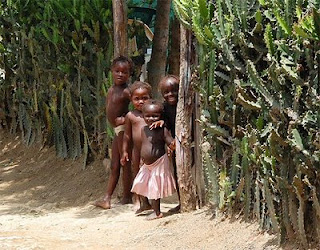
 “The idea of being a citizen of the world is still controversial,” said Strobe Talbott at a March 12, 2009, event examining the “great experiment” of global governance. Nevertheless, Talbott, president of The Brookings Institution, argued that global governance will be key to solving three of the greatest challenges the world faces: nuclear proliferation, climate change, and the financial crisis. This event was co-sponsored by the Wilson Center’s Environmental Change and Security Program and the
“The idea of being a citizen of the world is still controversial,” said Strobe Talbott at a March 12, 2009, event examining the “great experiment” of global governance. Nevertheless, Talbott, president of The Brookings Institution, argued that global governance will be key to solving three of the greatest challenges the world faces: nuclear proliferation, climate change, and the financial crisis. This event was co-sponsored by the Wilson Center’s Environmental Change and Security Program and the 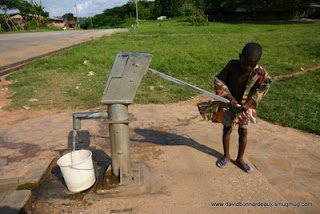

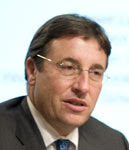 “Can we get beyond the point where environment and conflict always has to be a story of tragedy with no happy ending?” asked Achim Steiner at the March 24, 2009,
“Can we get beyond the point where environment and conflict always has to be a story of tragedy with no happy ending?” asked Achim Steiner at the March 24, 2009, 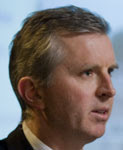
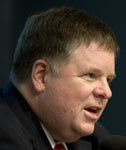 According to Reifsnyder, the U.S. government frequently supports UNEP initiatives, such as the $1.8 million in U.S. funding for a UNEP reforestation and energy-efficiency program in an internally displaced persons camp in Darfur. This project grew out of the
According to Reifsnyder, the U.S. government frequently supports UNEP initiatives, such as the $1.8 million in U.S. funding for a UNEP reforestation and energy-efficiency program in an internally displaced persons camp in Darfur. This project grew out of the 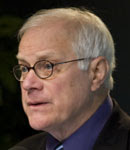 Duff Gillespie of the Johns Hopkins Bloomberg School of Public Health showed that U.S. funding for family planning has been stagnant in real dollars since the late 1960s, despite the fact that there are 200 million women with an unmet need for family planning. Without champions within USAID and the Obama administration, he said, the dollar amounts appropriated for family planning are unlikely to increase.
Duff Gillespie of the Johns Hopkins Bloomberg School of Public Health showed that U.S. funding for family planning has been stagnant in real dollars since the late 1960s, despite the fact that there are 200 million women with an unmet need for family planning. Without champions within USAID and the Obama administration, he said, the dollar amounts appropriated for family planning are unlikely to increase.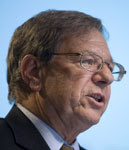 According to Steven Sinding of the Guttmacher Institute, although most economists and demographers agree that economic growth leads to lower fertility,
According to Steven Sinding of the Guttmacher Institute, although most economists and demographers agree that economic growth leads to lower fertility, 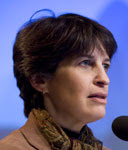 Ruth Levine of the Center for Global Development urged the authors to avoid “preaching to the choir.” One way to engage other constituencies interested in demographic issues is to broaden the scope of “population” to include not only family planning, but also
Ruth Levine of the Center for Global Development urged the authors to avoid “preaching to the choir.” One way to engage other constituencies interested in demographic issues is to broaden the scope of “population” to include not only family planning, but also 

